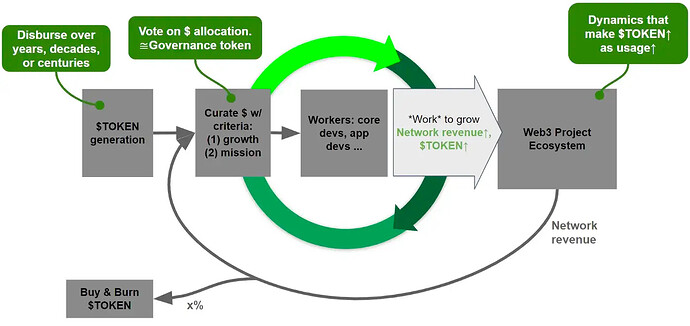Studying Token Engineering I learned the following: There are (at least) two perspectives how one can look at blockchain projects and their way of trying to make a living and become thriving ecosystems (= secure the network, increase token value, generate network revenue, become self-sustaining)
1) The Web3 Sustainability Loop
The Web3 Sustainability Loop focuses on (a) token dynamics such that token value goes up as volume goes up (top right); and (b) using Network Revenue to do work to grow volume further. As a bonus, some tokens get burned as function of volume, which drives token value further yet (bottom left). This model directly links usage to value, and is amenable to valuation approaches like Net Present Value.
2) The Network Flywheel
In the Network Flywheel, “Token Value” has two inputs: (a) Investors who “provide financial capital” to founders to “build the protocol and bootstrap some initial token value”, and (b) Vision + Protocol: “the stronger the vision for the token value is, the more the value in the broader market” as the loop goes. This model relies more on investor sentiment, without strong connection between usage and token value.
Source and learn more here: https://blog.oceanprotocol.com/the-web3-sustainability-loop-b2a4097a36e or take the Token Engineering Academy Module 1 Training (it is academic, be warned, but I feel it was worth my time and effort).
Here is my reflection:
I have not yet seen much in-depth thinking, designing, architecting and engineering a Web3 Sustainability Loop for Gitcoin.
![]() As a protocol DAO with an impact arm, shouldn’t we look more at how the relationships between the 3 most important things outlined above are intended to develop: Which incentives drive which behaviours and how the protocols interact in order to enable a thriving ecosystem?
As a protocol DAO with an impact arm, shouldn’t we look more at how the relationships between the 3 most important things outlined above are intended to develop: Which incentives drive which behaviours and how the protocols interact in order to enable a thriving ecosystem?
And then… there is something else that shows up for me… Aren’t we stuck at the point in the Network Flywheel where Miners and Validators come in? Miners and validators are the ones who, in exchange for a reward from the protocol, contribute the production capital—i.e. computational resources—that give the network its functionality and security.
![]() There is no incentive yet (no reward from the protocol(s)) for the ones who give the Gitcoin network its security!
There is no incentive yet (no reward from the protocol(s)) for the ones who give the Gitcoin network its security!
To sum up: YES, and! Yes to your most important things listed here and the relationships (the “whitespace”) between them!

